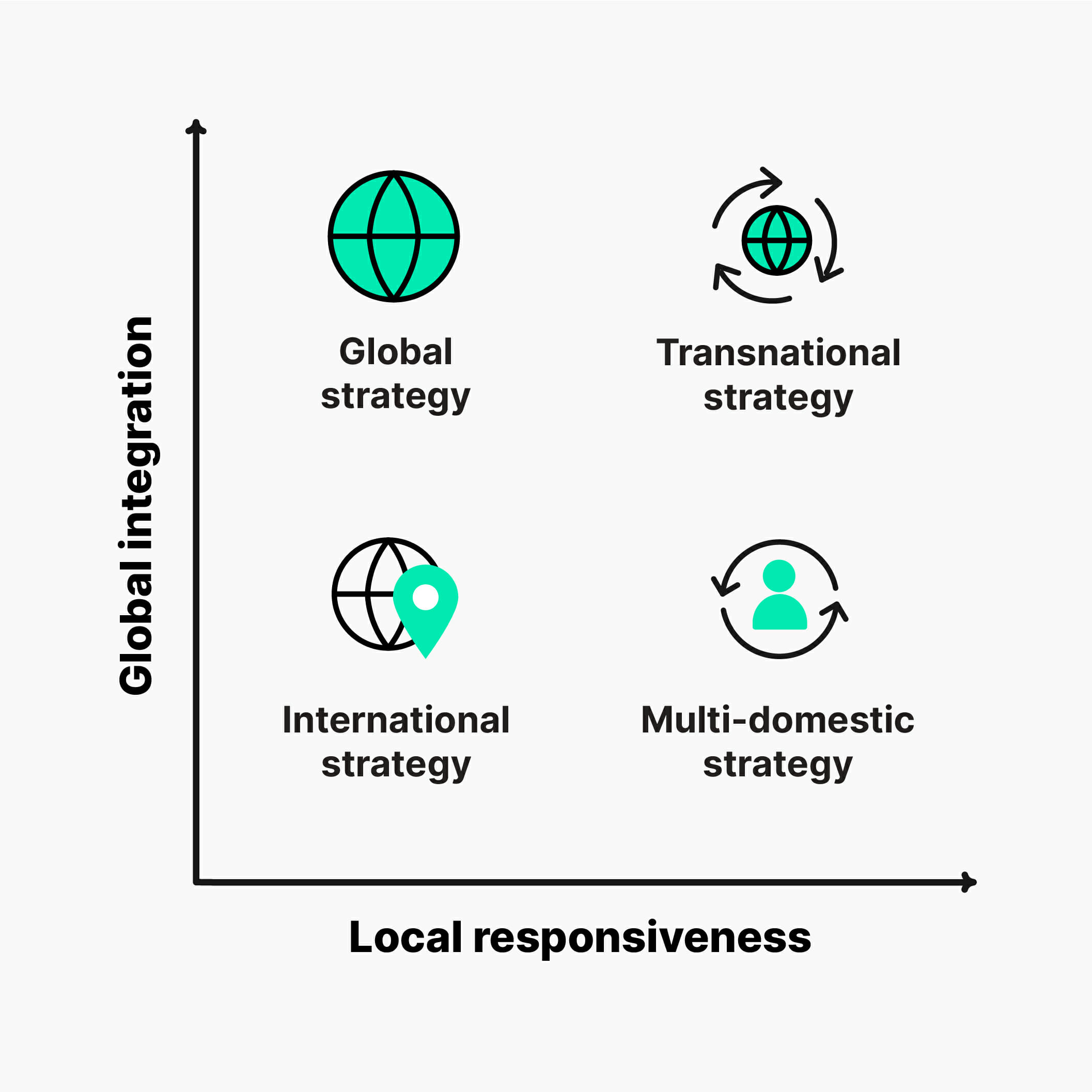Global business
The Manager’s Guide to Global Expansion

Growing organizations often start thinking about going global—expanding internationally beyond their original market to new customers overseas or in other countries.
It’s an exciting time for your business, but global expansion is also a complex process and decision with many important considerations.
To help you get started, we created this guide on global expansion strategies, risk management, and planning best practices.
What is global expansion?
Global expansion is a company’s growth into operations outside domestic markets—into one or more other countries or regions. There are several different ways to expand internationally and different reasons for international growth.
What is the purpose of global expansion?
Global expansion opens new opportunities for organizations, improving profitability, creating new revenue, and enhancing the company’s reputation. There are many benefits to expanding your business globally and international organizations can test the limits of what is possible for their brands and their target customers.
Just as founders build businesses for many different reasons, business leaders expand globally with many unique motives and goals in mind.
Types of global expansion strategies
Global expansion strategies enable organizations to work internationally, reaching markets outside of their own domestic market and gaining access to business opportunities in other parts of the world.
Multinational companies operate in multiple countries—in contrast with domestic companies, which operate in a single country. This strategy is often pursued to gain access to more consumer markets or become a supplier to new customers in other business-to-business (B2B) markets.
Generally, companies expanding globally follow one of these 4 key global expansion strategies:

International strategy
Applying an international strategy involves entering a new market without significantly changing product features or pricing strategy. Products or services are sold at similar price points and with the same branding, functionality, and design.
To casual observers, your product would probably be identical regardless of which country or region they buy it in. It wouldn’t be cheaper than it was before, even if local competitors offer a similar product at a different price. An International strategy doesn’t involve lowering the price to compete with local alternatives.
Essentially, it’s as if you “drag and drop” your product directly into the new market without reframing how it’s sold based on cultural differences or expectations. Buyers may see your product as more appealing if they prefer to purchase a product they perceive as foreign—they may also buy your product because they like what they see about your company and overall brand.
Rolex watches are a great example of international strategy at work. A Rolex timepiece is made in Switzerland and appeals to buyers based on the brand’s reputation for quality. Wherever you are in the world, if you look for a Rolex watch, you’ll probably find similar pricing and the same designs and options available. You can generally expect Rolex watches that are designed for the Swiss market to look the same and have the same quality that Rolex watches sold in the United States (US), Italy, France, the UK, or anywhere else have.
Multi-domestic strategy
By using a multi-domestic strategy, other companies take a different approach that adapts to local cultures and markets. Each country’s unique local tastes and preferences are accounted for with products or services that are customized to be more competitive within that particular market. Similar to an international strategy, a multi-domestic strategy doesn’t compete primarily on pricing.
Your brand, within a different domestic market, may very well offer a significantly different version of the product you currently sell today. Modifying what you offer to fit different customs could potentially make your products more profitable if customers see the changes as a sign that your company is now a better fit for their needs and preferences.
For some companies, this approach of unique modifications for each market could be expensive, but a multi-domestic strategy doesn’t focus on reducing prices to gain market share. Your products will still have the same pricing in a different market.
Lay’s, a potato chip brand based in the US and a wholly owned subsidiary of PepsiCo, has other brand names operating in other countries. UK customers buy Walkers’ crisps in flavors such as paprika that would be uncommon or unavailable in Lay’s domestic market.
Global strategy
In direct contrast to multi-domestic, a global strategy involves building cost-effective operations for international markets, which minimize local and regional variation. Products or services are largely the same in every market to reduce costs as much as possible and become an industry leader. Companies following this approach want to undercut competitor pricing in every market they operate in.
If you follow a global strategy, your company will probably differentiate from competitors through pricing leadership. You will seek to win market share in the countries you operate in by offering the best prices, but your products won’t adapt uniquely to each culture—even if there are local preferences you could consider.
For products where the price is important but customization isn’t, a global strategy is a particularly good fit. Components supplied for manufacturing consumer products are one example.
Perhaps one of the best-known companies using a global strategy is Coca-Cola. This popular brand’s soft drinks are fairly uniform around the world—a “Coke” may be packaged, distributed, or promoted differently in different markets, but it’ll probably taste the same whether you buy it in the US or Germany.
Transnational strategy
For companies that want to build both customization and reduced costs into their global expansion strategy, a transnational strategy may be the best choice. Transnational strategy looks for ways to optimize product fit within each market while also managing costs and process efficiencies. Most of the products are very similar, making it possible to use the same suppliers and avoid having to create separate supply chains, reducing the costs associated with selling to multiple markets. Some minor customization is easily added on without creating too much change or extra costs.
Ice cream company Baskin Robbins sells different flavors of ice cream in different countries, often taking inspiration from local cuisines. In Asia, you might find matcha and chocolate ice cream—but not at all Baskin Robbins stores around the world.
The benefits of global business expansion
Global business expansion offers many tangible benefits for organizations. Interest in global growth is strong because companies know that international expansion is a great way to grow a business, create new revenue streams, build brand recognition, and hire global talent.
Global expansion elevates business growth
Expanding a business internationally provides companies with access to additional markets. Entering new markets helps businesses grow beyond the customers and prospective buyers in their original country. A worldwide market means more potential buyers, markets with different needs and preferences, and markets operating within different regulatory requirements.
Global expansion creates new revenue streams
Entering new markets internationally gives organizations additional income, helping them become more resistant to market shocks and changes in domestic market conditions. Growing revenue by expanding internationally could be as straightforward as making products available online within additional countries, or as complex as building new factories and fulfillment centers overseas.
Regardless of how your organization enters a global market, the potential for revenue growth is a realistic possibility. You can use this revenue to strengthen your profitability.
Global expansion boosts your global brand recognition
By reaching other markets, your organization builds brand awareness and brand recognition with potential customers. Global expansion makes it possible for your company to become better known and establish a recognizable reputation. This creates new possibilities for product promotion and strengthens your brand.
Once you’ve gained recognition outside your home market, reaching additional markets often becomes easier—you already know how to communicate relevance to a new market with new customers. You may have success you can use to launch your reputation into nearby countries, the rest of the continent, or a new region. After taking your business into Canada, for example, you may more easily expand into the United States.
Global expansion gives you access to an international talent pool
As your company grows across borders, hiring great talent from other countries generally becomes easier to accomplish. Better name recognition for your brand and familiarity with other markets can be very helpful when you’re recruiting—and access to an international talent pool provides your company with the opportunity to hire the best people.
Global expansion risks
With many business decisions, there is risk involved. Global expansion can be risky as well, and it’s worthwhile to prepare risk reduction and mitigation strategies before you get started.
Ignorance or lack of understanding of cultural differences
Cultural differences can be very significant and their impact on business shouldn’t be ignored or underestimated. Social, linguistic, religious, and other misunderstandings could harm otherwise strong business plans. Decisions that show ignorance of culture can backfire and pose a serious threat to any company expanding overseas. Well-prepared business leaders carefully consider cultural differences throughout the global expansion process.
For example, if product packaging includes a color that’s offensive or inappropriate artwork, customers may reject the brand. Clothing styles that are fashionable in one country may be considered immodest or unusual in another cultural context.
Incomplete insight into political, legal, and compliance environments
The wrong move on a compliance issue can be fairly costly for your business. Imagine being unaware of a tax you’re required to pay, regulations in place before you can advertise your product in another country, or other compliance conditions with significant risks.
That’s why it’s advisable to research and enlist a professional’s services—if necessary—before expanding your business internationally. At the very least, this could save you money and future hassle, if not prevent serious trouble altogether.
Potentially higher initial investment and waiting for long-term gains
Before you expand globally, it makes sense to count the costs and have a realistic assessment of when you’ll break even or generate a profit on the investment. International businesses may incur higher costs and unexpected expenses that eat away at profit margins. That’s why upfront research, profit projections, and estimates are always helpful.
Insufficient attention to marketing and advertising requirements
Marketing and advertising can work quite differently from one culture to another. Even if you’re using the same platforms or channels for reaching potential customers, you may have to follow another process to get started in another country, and this could be much different from what you anticipated. Closely related, what is important to your market today may not fit with what other markets value.
For example, different countries often use different social media channels: While Facebook tops the US market, VK (Vkontakte) is the preferred social media platform in Russia. Similarly, planning around the popularity of Google Search isn’t as helpful for businesses planning to launch a website in China, where Baidu is a more popular search engine. This makes it obvious that you should adapt your product to the habits of your target audience if you want to be seen.
Global expansion tips
Following these steps to entering international markets can help your organization prepare for an effective global expansion.
Market research
For just about everything about international business, market research is your friend—use your research to help you plan your resources and mitigate risks.
During your research, you may want to explore these areas further:
- Market audience: Who is your target customer? Consider creating a persona by choosing a real-life or fictional person (or company) who represents your ideal customer. Who are they, and what do they want? This will help you understand customer needs in each of your target markets.
- Market demand: Is there a demand for your product or service? How big is that demand? The more you can quantify your estimate the better.
- Trends: How is your type of product or service perceived by customers? What are customers looking for and how do they usually choose the right brand or the right product? How much change or stability does the market have?
- Market entry strategy: How will you enter the market and what factors influence your market entry strategy? You may want to consider logistical details, business goals, lists of action items you’ll need to complete, and what timeline you should expect to follow.
Use the PESTEL framework
Another helpful research tool is PESTEL, which represents political, economic, social, technological, environmental, and legal influences. Each aspect of PESTEL can have an impact on your business, so it may be helpful to research and plan for PESTEL factors in each target country you plan to operate in.
- Political: The country’s government, leadership, political stability, and political climate
- Economic: The general economic outlook in the target country as well as your industry’s economic health
- Social: Cultural values, social beliefs, religious and philosophical points of view, etc.—this can include cultural history and memory
- Technological: Benefits and limitations of technology available in a particular market as well as regulations surrounding its use—this includes not only the technology your company uses but also technology available to your customers
- Environmental: Local environmental issues, regulation, and history
- Legal: The regulatory standards and processes your company will need to comply with
To conduct a PESTEL analysis of a target market, it’s important to research and document as many political, economic, social, technological, environmental, and legal conditions as possible:
- How are the PESTEL factors different from your original market?
- Using PESTEL, what risks are present? How do these impact your brand?
- Are there advantages or benefits that your brand has over competitors in these areas?
- What should you be watching for—is there developing news or are there current events that could change your market entry strategy?
When in doubt, it’s recommendable to over-research rather than make a guess or act without good information. Research helps you protect your business from risk and reach your goals more effectively.
Learn from your competition
If you have competitors who are already reaching another market, taking a close look at their work could help you define your own market positioning in a manner that stands out from them. Here are a few things to consider:
- Who are your competitors in that target market?
- Are your competitors local or foreign companies?
- What do you think your competitors are doing well?
- Similarly, what are your competitors doing poorly in your view?
- What’s your business better at?
- Is your investment likely to generate a return, even with these competitors in the same industry?
Whenever possible, learn from your competitors’ discoveries and mistakes—it’s less expensive to learn from someone else’s decisions. Competitors are a great source of information about your market.
Rely on local experts across fields
Local expertise is valuable for organizations undertaking global expansion. If you can, hire local personnel or find experts who are familiar with your target market. Aside from their subject matter expertise, these experts can also help you understand important cultural differences and localization considerations you may have otherwise overlooked.
Ask yourself before you start working with a local expert:
- What fields should I hire local experts in?
- What is their experience with this target market or culture?
- Could this expert help my business build our global reputation and local trust?
Adapt your product for international markets
To get a foothold in the constantly evolving and highly competitive global marketplace, taking into account differences between markets is key. Potential customers in each target market need to be able to understand your product or service from the start and relate to it on an emotional level before making a buying decision.
For example, if your online store doesn’t respect local date and time formats or local online shopping habits, it can be a signal that the product is of lesser quality or even illegitimate. This makes it clear that translation isn’t enough—a global product launch isn’t only about transferring a website or marketing assets from one language to another.
Localization is integral to global expansion strategies
Making your product accessible to people across markets means adapting it to cultural differences, linguistic particularities, local expectations, purchasing power and habits, and legal requirements—just to name a few aspects of a process as complex as localization. Integral to global expansion, localization requires a clear strategy and robust technology.
A clear localization strategy will ensure that localization results in a product that potential users can’t identify as an adapted version of an existing original. This means that people in your target market will compare your localized product with “native” offers and find no difference in understanding, buying, and using your product or service.
The key to effective localization is in allocating the most resources to everything that can’t get automated—think global strategy, product design, or campaign copywriting—while automating as many repetitive and time-consuming tasks associated with your localization workflow as possible. In that respect, localization technology can be your greatest ally on the way to global domination.
Make a splash in international business
With significant benefits to global expansion, it’s little wonder that so many companies choose international growth strategies. Expanding globally is a bold step that can provide additional revenue for your company and help you grow your reputation. Using one of the 4 global expansion strategies provides your business with a solid blueprint for a successful transition.
Developing the right market entry strategy for your business can help you mitigate risk, stay compliant, and generate more interest in your product or service. By localizing your product, you prepare to reach customers more effectively and position your company for better results.

Unlock global business with the Phrase Localization Platform
Expand into new markets with all the tools you need in one technology suite for high-quality, fast, and scalable localization.





